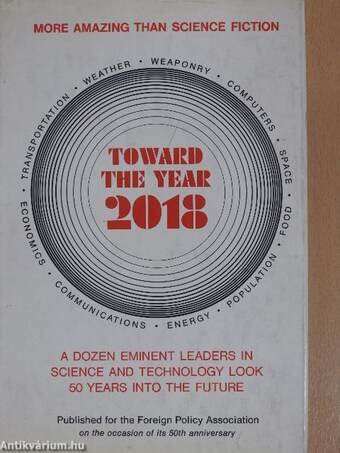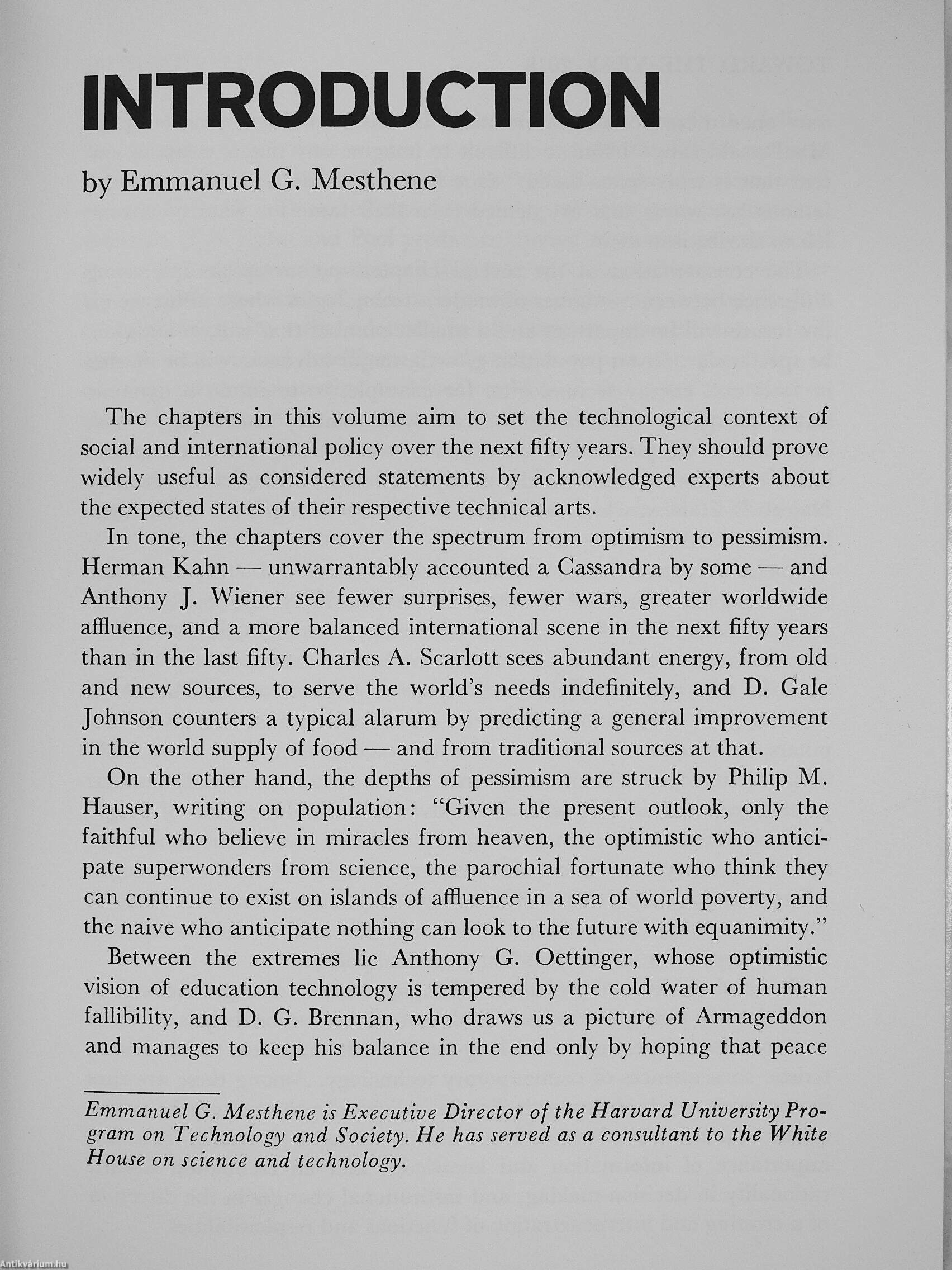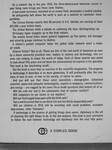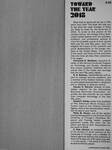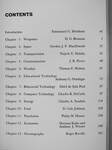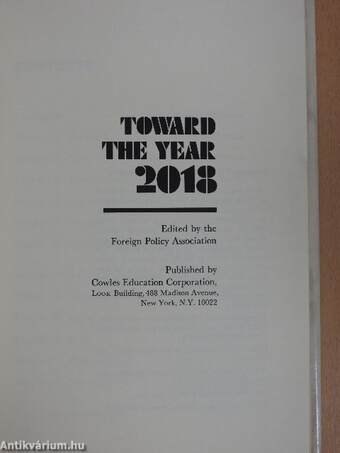1.104.827
kiadvánnyal nyújtjuk Magyarország legnagyobb antikvár könyv-kínálatát

VISSZA
A TETEJÉRE
JAVASLATOKÉszre-
vételek
Toward the Year 2018
More Amazing Than Science Fiction/Weather, Weaponry, Computers, Space, Food, Population, Energy, Communications, Economics, Transportation/A Dozen Eminent Leaders in Science and Technology Look 50 Years into the Future
| Kiadó: | Cowles Education Corporation-Foreign Policy Association |
|---|---|
| Kiadás helye: | New York |
| Kiadás éve: | |
| Kötés típusa: | Vászon |
| Oldalszám: | 177 oldal |
| Sorozatcím: | |
| Kötetszám: | |
| Nyelv: | Angol |
| Méret: | 23 cm x 16 cm |
| ISBN: | |
| Megjegyzés: | 1. kiadás. További kapcsolódó személyek a könyvben. |
naponta értesítjük a beérkező friss
kiadványokról
naponta értesítjük a beérkező friss
kiadványokról
Előszó
TovábbFülszöveg
On a summer day in the year 2018, the three-dimensional television screen in your living room brings you these news flashes:
A man-made hurricane, launched at an enemy fleet, devastates a neutral country.
An anti-gravity belt above the earth is seen as a solution to commuter transportation.
The Census Bureau reports that 60 percent of U.S. families are earning at least $25,000 a year before taxes.
The United Nations holds a debate on outlawing the laser disintegrating ray.
Oil-hungry Japan snuggles up to the Arab nations.
The weekly Social Index shows general happiness up five points, but teenager and minority groups continue to decline.
A citizen's pocket computer helps the global radar network avert a major air crash.
Science fiction? Not at all. These are bits of the real world of tomorrow as seen by a dozen eminently practical men, leaders in science and technology, who are even now helping to shape the world of today. Each of these experts was asked to look ahead... Tovább
Fülszöveg
On a summer day in the year 2018, the three-dimensional television screen in your living room brings you these news flashes:
A man-made hurricane, launched at an enemy fleet, devastates a neutral country.
An anti-gravity belt above the earth is seen as a solution to commuter transportation.
The Census Bureau reports that 60 percent of U.S. families are earning at least $25,000 a year before taxes.
The United Nations holds a debate on outlawing the laser disintegrating ray.
Oil-hungry Japan snuggles up to the Arab nations.
The weekly Social Index shows general happiness up five points, but teenager and minority groups continue to decline.
A citizen's pocket computer helps the global radar network avert a major air crash.
Science fiction? Not at all. These are bits of the real world of tomorrow as seen by a dozen eminently practical men, leaders in science and technology, who are even now helping to shape the world of today. Each of these experts was asked to look ahead fifty years and set down the achievements he expects in his specialty. This book is the fascinating result.
But the book is more than an exercise of the scientific imagination. The progress in technology it describes is no mere gimmickry. It will profoundly alter the relations of man to man, of man to his society, of nation to nation.
And you will see that these sober specialists— demographer, behavioral scientist, space and computer technologists, experts in weaponry, communications, and energy— are nagged by the same life-or-death questions that bedevil all of us.
Will the cold war end in the cataclysmic heat of nuclear conflict?
Will computers be our slaves or our masters?
Will our food supply keep pace with the birth rate?
Can a world survive that is one-third rich and two-thirds desperately poor?
Will our children in 2018 still be wrestling with racial problems, economic depressions, other Vietnams?
If technology is the science of getting things done easier, diplomacy is the art of choosing the right things to do. In the last analysis, this book is your scorecard to follow the race between technology and diplomacy over the next fifty years.
A COWLES BOOK
5.95
TOWAKII THG YGAK
2018
What kind of world will we live in fifty years from now? This book will help you to see what the rapid changes of today are likely to mean for the tomorrow of 2018. To arrive at this picture of the coming century, the Foreign Policy Association asked experts from the business, academic, and professional spheres to chart the probable course of each special field over the next fifty years. Each has weighed the impact of the scientific and social developments on the foreign relations of the United States. This volume is the result, and these are the prominent men who have set down their predictions in its pages:
Emmanuel G. Mesthene, executive director of the Harvard University Program on Technology and Society, introduces this unique, prophetic collection with an overall view of the hopes and warnings that the next fifty years signify.
D. G. Brennan, mathematician and expert on national security problems, and a member of the Hudson Institute, writes on anticipated developments in weaponry and in methods of weapons control.
Charles R. DeCarlo, director of automation research for the International Business Machines Corporation, describes the new miracles we can expect from computer technology in the next fifty years.
Najeeb E. Halaby, senior vice-president of Pan American World Airways and former head of the Federal Aviation Agency, tells of the transportation revolution he sees in your future.
Philip M. Hauser, one of the world's leading demographers and director of the University of Chicago's Population Research and Training Center, projects population trends fifty years into the future and tells of their implications for the world of 2018.
D. Gale Johnson, an economist, dean of the division of social sciences at the University of Chicago, and a member of federal agencies dealing with problems of food and foreign aid, talks about how well — or how poorly — the world of 2018 will be able to feed its people.
continued on back flap Vissza



